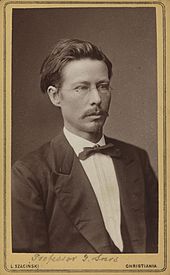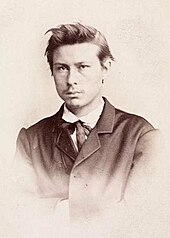Georg Ossian Sars
Georg Ossian Sars (born April 20, 1837 in Florø , † April 9, 1927 in Oslo ) was a Norwegian zoologist . He was particularly interested in the systematics of crustaceans .
Life
Origin and education
Georg Ossian Sars was the fourth child of the clergyman and zoologist Michael Sars and his wife Maren Cathrine nee. Welhaven (1811–1898), a sister of the poet Johan Sebastian Welhaven . He grew up in Manger on the island of Radøy , where his father was a pastor from 1839 . From 1852 he attended the cathedral school in Bergen . Two years later the family moved to the capital Christiania because Michael Sars had been appointed associate professor at the Royal Friedrichs University , and Ossian switched to the cathedral school there. From 1857 he studied medicine and natural history in Christiania . Inspired by a book by the Swedish zoologist Vilhelm Lilljeborg , he discovered his interest in crustaceans. As a student, he accompanied his father on summer excursions through Norway. In his first essays he described numerous new species of copepods , woodlice , cumacea and mussel crabs . In 1862 he received the Kronprinzen Gold Medal ( Kronprinsens gullmedalje ) for a work on Norway's freshwater crabs .
Scientific career
Starting with a scholarship for 1864, Sars worked mainly in the field of fisheries science until 1870 . He discovered that cod spawns swim close to the surface and are therefore exposed to ocean currents. Until then, it was assumed that it sinks to the bottom like that of the Atlantic herring and adheres there. In the years that followed, Sars found that the eggs of not only cod, but almost all fish species economically used in Norway are pelagic . But he also explored in this period, the crustaceans and justified in the zoological taxonomy, the subclass of Myodocopa (1866) and the orders of anostraca (Anostraca 1867), Notostraca (1867), Myodocopida (1866), Platycopida (1866), Podocopida (1866 ) and Lophogastrida (1870). The mussel shells (Conchostraca SARS 1867) are under scientific discussion today with regard to their status as a valid taxon .
In 1870 Sars returned to Christiania University, where he was appointed professor of zoology in 1874, succeeding Halvor Rasch (1805-1803). During this time, Ossian Sars finished several publications that his father, who died in 1869, had begun. He was already considered an excellent carcinologist, so that collected material from scientific expeditions was also given to him. He edited z. B. the Cumacea of the Swedish Arctic expeditions Otto Torell from 1861 and Adolf Erik Nordenskiöld from 1868 as well as the Atlantic expedition of the HMS Josephine from 1869.
In the winter of 1875/76 he traveled to the Mediterranean , mainly visiting Italy , but also Malta and Tunisia . After his return he founded a new scientific journal, the Archiv for Mathematik og Naturvidenskap, with his professor colleagues Sophus Lie and Jakob Worm Müller (1834–1889) . During the next few years he published several papers on hover shrimp , cumacea, woodlice and mussel crabs , which he had brought back from his trip. He remained the editor of the magazine throughout his life, the establishment of which led to the fact that the publication of scientific papers in Norway almost doubled. She was the Norwegian mouthpiece of the new scientific currents in Europe. Alongside his brother, the historian Ernst Sars , he was soon considered the most prominent representative of Darwinism in Norway.
From 1876 to 1878, Sars and the meteorologist Henrik Mohn led the Norwegian North Sea expedition with the steamship Vøringen . In the summer months, the ship sailed the European North Sea as well as parts of the eastern Greenland Sea off Spitsbergen and the western Barents Sea . While Mohn was interested in the influence of the sea on the climate in Norway and the ocean currents , Sars was interested in clearing up the fish migrations and in discovering and describing as yet unknown marine animals, especially those from the deep sea . Both were successful. About 300 new species have been described by Sars and his colleagues. Following the expedition, he was able to create a map of the spawning courses for cod from the Greenland and Barents Seas to the Lofoten Islands . Sars' scope of work was enormous: while he was busy preparing and leading the expedition, he published an extensive work on Norway's arctic molluscs in 1878.
Crustaceans increasingly determined his further scientific life. As an internationally recognized expert, he worked on the material of various foreign expeditions, including the British Challenger expedition . He wrote twelve treatises on crustaceans from the Caspian Sea , which various Russian expeditions had sent him, and others on those from African lakes. In the last years of his life he was still working on expedition material for Prince Albert I of Monaco . He founded further orders such as the Monstrilloida (1901), Harpacticoida (1903) and Calanoida (1903).
Since the 1880s, he has had dried mud brought from lakes on different continents in order to be able to observe the water fleas , copepods and mussel crabs hatching from their eggs in the freshwater aquarium . Little by little, he examined mud from Australia , New Zealand , South Africa , Brazil , Argentina , Algeria , India , China , Sumatra , South Georgia and British Malaya .
Ossian Sars' main work is An Account of the Crustacea of Norway , which appeared in nine volumes between 1890 and 1928 and was edited by the Bergen Museum . In brief descriptions and excellent drawings, he depicted the world of Norwegian crustaceans.
Late years
In 1918 Ossian Sars retired. But it was allowed to keep its laboratory at the university. His salaries continued to be granted to him. Sars continued his work until just before his death. He died after a short illness just two weeks before his 90th birthday.
family
Georg Ossian Sars was never married. Like his brother Ernst, he lived with his mother until she died in 1898. Afterwards the brothers lived with their sister Mally (1850-1929) and her husband, the singer and composer Thorvald Lammers . The younger sister Eva was married to Fridtjof Nansen .
Honors
The University of Uppsala awarded Ossian Sars an honorary doctorate in 1877 . In 1882 he was elected a member of the Leopoldina . The Linnean Society of London awarded him the Linné Medal in 1910 . In 1892 he became a knight and in 1911 commander of the Order of Saint Olav . Since 1896 he was a corresponding member of the Russian Academy of Sciences in St. Petersburg and since 1898 of the Prussian Academy of Sciences and since 1920 honorary member ( Honorary Fellow ) of the Royal Society of Edinburgh .
After Sars there are several geographical objects such as the island of Sarsholmen, the lake Sarsvatnet, the mountain Ossian Sarsfjellet (all Spitzbergen ), the volcanic crater Sarskrateret on Jan Mayen , the shallows of the Sarsbanken in the European Northern Sea and the Sars Strait (Proliw Sarsa) between the Freden- and the Eva-Liv-Insel in Franz-Joseph-Land . The Ossian-Sars nature reserve on the island of Spitzbergen also bears his name. Several Norwegian research vessels were named GO Sars . The journal Sarsia (since 2005: Marine Biology Research ) and the Sars Center for Marine Molecular Biology are named after Michael and Ossian Sars.
Fonts (selection)
- Historie naturelle des Crustacés d'eau douce de Norvège , Chr.Johnsen, Christiania 1867.
- Bidrag to Kundskaben om norges arctic fauna. I. Mollusca regionis arcticae norvegiae. Oversigt over de i norges arctic region forekommende bløddyr , Christiania 1878.
- Carcinologiske Bidrag til Norges Fauna. Monographi over de ved Norges kyster forekommende Mysider , Christiania, 1st issue 1870, 2nd issue 1872, 3rd issue 1879.
- Report on the Schizopoda collected by HMS Challenger during the years 1873-76 , London 1885.
- Den Norske Nordhavs Expedition 1876–1878 , Grøndahl, Christiania, Vol. 6: Crustacea I 1885, Crustacea II 1886, Pycnogonidea 1891.
- An account of the Crustacea of Norway, with short descriptions and figures of all the species , Cammermeyers Forlag, doi : 10.5962 / bhl.title.1164 ,
- Vol. 1: Amphipoda , 1895; Vol. 2: Isopoda , 1899; Vol. 3: Cumaceae , 1899; Vol. 4: Copepoda. Calanoida , 1901; Vol. 5: Copepoda. Harpacticoida , 1911; Vol. 6: Copepoda. Cyclopoida , 1913; Vol. 7: Copepoda. Supplement , 1919; Vol. 8: Copepoda. Monstrilloida & Notodelphyoida , 1921; Vol. 9: Ostracoda , 1922-1928.
- Fauna Norvegiae , Volume 1: Phyllocarida and Phyllopoda , Christiania 1896.
- An account of the Crustacea of Norway, with Short Descriptions and Figures of all the Species , 9 volumes, published by the Bergen Museum, Bergen, for sale by Cammermayer-Verlag, Christiania and Copenhagen 1895–1928.
- Copépodes particulièrement bathypélagiques provenant des campagnes scientifiques du Prince Albert Ier de Monaco . In: Résult. Camp. scient. Prince Albert I 69, 1925, pp. 1-408.
literature
- Marit E. Christiansen: Georg Ossian Sars (1837-1927), the great carcinologist of Norway . In: Frank Truesdale (Ed.): History of Carcinology . Balkema, Rotterdam 1993, ISBN 90-5410-137-7 , pp. 143–164 ( limited preview in Google Book search).
Web links
- Geir Hestmark: GO Sars . In: Norsk biografisk leksikon (Norwegian)
- Georg Ossian Sars , entry in Nordisk familjebok
Individual evidence
- ^ Marit E. Christiansen: Georg Ossian Sars (1837-1927), the great carcinologist of Norway , p. 143.
- ↑ Kronprinsens gullmedalje , accessed on August 5, 2015.
- ^ Marit E. Christiansen: Georg Ossian Sars (1837-1927), the great carcinologist of Norway , p. 144.
- ^ A b Joel W. Martin, George E. Davis: An Updated Classification of the Recent Crustacea (PDF; 757 kB). Natural History Museum of Los Angeles County, Science Series 39, 2001.
- ^ A b Marit E. Christiansen: Georg Ossian Sars (1837-1927), the great carcinologist of Norway , p. 145.
- ↑ Arild Stubhaug: It was the boldness of my thoughts. The mathematician Sophus Lie . Springer-Verlag, Berlin Heidelberg 2013, ISBN 82-03-22297-8 , p. 256 ( limited preview in Google book search - Norwegian: Det var mine tankersdjervhet - mathematicians Sophus Lie . Oslo 2000. Translated by Kerstin Hartmann-Butt).
- ↑ Arild Stubhaug: It was the boldness of my thoughts. The mathematician Sophus Lie , p. 259.
- ↑ Marit E. Christiansen: hav Stormfullt. The Norske Nordhavs Expedition. 1876–1878 on the website of the Natural History Museum Oslo , February 9, 2009, revised version from February 24, 2012, accessed on August 7, 2015.
- ^ Marit E. Christiansen: Georg Ossian Sars (1837-1927), the great carcinologist of Norway , p. 150f.
- ↑ Geir Hestmark: GO Sars . In: Norsk biografisk leksikon (Norwegian).
- ^ List of members Leopoldina, Georg Ossian Sars
- ^ Foreign members of the Russian Academy of Sciences since 1724: Sars, Georg Ossian. Russian Academy of Sciences, accessed April 5, 2020 (Russian).
- ^ Fellows Directory. Biographical Index: Former RSE Fellows 1783–2002. (PDF file) Royal Society of Edinburgh, accessed April 5, 2020 .
| personal data | |
|---|---|
| SURNAME | Sars, Georg Ossian |
| BRIEF DESCRIPTION | Norwegian zoologist |
| DATE OF BIRTH | April 20, 1837 |
| PLACE OF BIRTH | Florø |
| DATE OF DEATH | April 9, 1927 |
| Place of death | Oslo |



